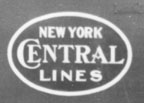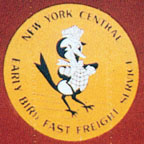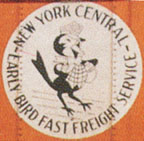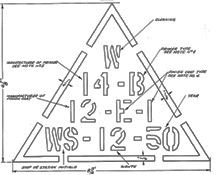|
FREIGHT
CAR PAINTING
Heralds
and Lettering style:
 *
The oval "Lines" herald prior to November 1935 had a black background
and was replaced with the oval "System" herald in November 1935.
Reporting marks and data were Roman style. Periods in the
reporting marks were no longer applied starting around 1929. *
The oval "Lines" herald prior to November 1935 had a black background
and was replaced with the oval "System" herald in November 1935.
Reporting marks and data were Roman style. Periods in the
reporting marks were no longer applied starting around 1929.
|
Oval
Sizes: |
Effective
Date: |
|
18"
x 9" used on flat cars, containers and container cars |
March 4, 1907 |
|
18"
x 12" used on flat cars, and special flat cars |
May 11, 1905 |
|
28-1/4"
x 19-1/8" used on self clearing hoppers, gondolas, double deck
stock cars |
January 31, 1905 |
|
36"
x 24" used on single deck stock cars |
November 12, 1904 |
|
48-3/8"
x 32-1/2" used on boxcars and auto boxcars |
December 1904 |
 * Roman style "System" herald used between November 1935
and August 1955. Between November 1935 and March 1944 - the roman
"System" herald had a black background. The black
background officially removed from the roman "System"
herald starting March 2, 1944. Reporting marks and data were Roman style. Reporting
marks were 9" and car numbers were 7" on most cars.
* Roman style "System" herald used between November 1935
and August 1955. Between November 1935 and March 1944 - the roman
"System" herald had a black background. The black
background officially removed from the roman "System"
herald starting March 2, 1944. Reporting marks and data were Roman style. Reporting
marks were 9" and car numbers were 7" on most cars.
|
Oval
Sizes: |
Effective
Date: |
|
18"
x 9" used on flat cars, containers, container cars and special
flat cars |
November 25, 1935 |
|
28-1/4"
x 19-1/8" used on self clearing hoppers, gondolas and double
deck stock cars |
November 1935 |
|
36-3/8"
x 24" used on single and double deck stock cars with large letterboard |
November 1935 |
|
48-3/8"
x 32-1/2" used on boxcars and auto boxcars |
October 30, 1935 |
 *
Gothic style "System" herald used between August 1955 and May 1959. The
black herald background returned with the gothic "System" herald.
(NOTE: The gothic "System" herald was also used prior to 1955 on
Pacemaker boxcars and bay window cabooses. Reporting marks and data
were Gothic style.. Reporting marks were 11" and car numbers were
9" on most cars. *
Gothic style "System" herald used between August 1955 and May 1959. The
black herald background returned with the gothic "System" herald.
(NOTE: The gothic "System" herald was also used prior to 1955 on
Pacemaker boxcars and bay window cabooses. Reporting marks and data
were Gothic style.. Reporting marks were 11" and car numbers were
9" on most cars.
|
Oval
Sizes: |
Effective
Date: |
|
18-1/2"
x 10-1/2" used on flat cars, composite and 65' gondolas,
containers, container cars and special flat cars |
October 14, 1955 |
|
29"
x 19-3/8" used on cabooses, gondolas, tank cars, self clearing
hoppers, ballast cars, double and adjustable deck stock cars and auto racks |
September 7, 1955 |
|
31-5/8"
x 19-1/4" used on steel bay window cabooses lots 782 and 778 |
September 16, 1949 |
|
48-3/8"
x 32-1/2" used on Pacemaker boxcars |
1946 |
|
54-3/8"
x 37-3/4" used on boxcars and auto boxcars and repainted
Pacemaker cars after October 28, 1955 |
August 19, 1955 |
|
36"
x 24"" used on 70 ton welded triple hoppers |
November 15, 1956 |
 *
Blue and yellow Script herald of 1956 applied only to NYMX
mechanical refrigerator cars ( A modified version of this herald was
also applied to some locomotives during 1956 through 1959 ). This
herald is approximately 45" x 30". Reporting marks and data
were Gothic style. *
Blue and yellow Script herald of 1956 applied only to NYMX
mechanical refrigerator cars ( A modified version of this herald was
also applied to some locomotives during 1956 through 1959 ). This
herald is approximately 45" x 30". Reporting marks and data
were Gothic style.
 *
Yellow Early Bird herald applied only to Lot 862-B 50'
boxcars in 1957. ( This herald was also applied as a test on Lot
737-B 40' boxcar #174853 ). Reporting marks and data were Gothic style. *
Yellow Early Bird herald applied only to Lot 862-B 50'
boxcars in 1957. ( This herald was also applied as a test on Lot
737-B 40' boxcar #174853 ). Reporting marks and data were Gothic style.
 *
White Early Bird herald applied only to Lot 936 NYRB 2500-2599 in 1958 and changed to NYRX 2500-2599 in 1959 - 40'
insulated boxcars. Reporting marks and data were Gothic style. *
White Early Bird herald applied only to Lot 936 NYRB 2500-2599 in 1958 and changed to NYRX 2500-2599 in 1959 - 40'
insulated boxcars. Reporting marks and data were Gothic style.
 *
Experimental blue boxcar scheme applied to cars 92102 and 220539
in September 1958. Reporting marks and data were Gothic style. *
Experimental blue boxcar scheme applied to cars 92102 and 220539
in September 1958. Reporting marks and data were Gothic style.
 *
Cigar band 'test' cars appeared in November 1958 ( drawing dated
October 22, 1958 ) with the horizontal bar below the center line.
Applied only to 12 cars: 176326, 176349, 176697, 176747, 176893,
176920, 176941, 176981, 177128, 177158, 177234 and 177287 *
Cigar band 'test' cars appeared in November 1958 ( drawing dated
October 22, 1958 ) with the horizontal bar below the center line.
Applied only to 12 cars: 176326, 176349, 176697, 176747, 176893,
176920, 176941, 176981, 177128, 177158, 177234 and 177287
 *
Cigar band style herald officially adopted at 1959 Shareholders
meeting and cars started to be repainted in the Century Green scheme
June 1959. Originally, boxcars painted in the Century green had black
roof and ends. During 1963 - cars started to appear with entire car
body painted Century Green and smaller herald appeared on boxcars
starting in 1964. Covered hoppers and flexi-van flats were painted
gray with black lettering - despite what some model companies have
produced - the NYC did not paint covered hoppers Century Green. A
small number of covered hoppers were painted black ( usually assigned
to company sand service), but never green. It appears that Flexi-van
flats never received the cigar band herald. Lots 130G and 148G cars
had no heralds. *
Cigar band style herald officially adopted at 1959 Shareholders
meeting and cars started to be repainted in the Century Green scheme
June 1959. Originally, boxcars painted in the Century green had black
roof and ends. During 1963 - cars started to appear with entire car
body painted Century Green and smaller herald appeared on boxcars
starting in 1964. Covered hoppers and flexi-van flats were painted
gray with black lettering - despite what some model companies have
produced - the NYC did not paint covered hoppers Century Green. A
small number of covered hoppers were painted black ( usually assigned
to company sand service), but never green. It appears that Flexi-van
flats never received the cigar band herald. Lots 130G and 148G cars
had no heralds.
|
Oval
Sizes: |
Effective
Date: |
|
144" x
64" used on boxcars, auto boxcars, ACF cylindrical covered hoppers |
June 19, 1959 |
|
84"
x 37" used on 125 pressure differential covered hoppers,
cabooses and new built boxcars |
December 26, 1962 |
|
52"
x 24" scotchcal decal used on boxcars and cabooses |
May 6, 1961 |
|
52"
x 23-1/2" used on boxcars, auto boxcars, outside stake covered
hoppers and gondolas |
May 11, 1964 |
|
33-1/8"
x 15-5/8" scotchcal decal used on multi-level auto racks |
May 6, 1961 |
|
32-1/4"
x 14-5/8" used on rebuilt 65ton and 70 ton 2 bay hoppers - all
white with horizontal bars |
1964 |
|
32-1/4"
x 14-5/8" used on multi-level auto racks, transfer cabooses and
coil cars |
March 9, 1961 |
|
32-1/4"
x 14-5/8" used on 100ton gondola, lots 120G, 123G and 122F cars
- all white with no horizontal bars |
June 1967 |
|
30"
x 13-5/8" used on lot 959H cars only |
May 1965 |
 *
Variation of Cigar band style herald used by the Pittsburgh &
Lake Erie. *
Variation of Cigar band style herald used by the Pittsburgh &
Lake Erie.
 *
Pacemaker cars painted starting in 1946 for service as cars were
modified from regular boxcar service to high speed lightweight
service. It took until 1953 before all 1000 lot 737-B cars were
modified and painted for Pacemaker service. Paint was
Sherwin-Williams flash-dri paint red over gray. Red door and side
sill under door when door in closed position also red. Ladders, grab
iron rungs, brake wheel, underframe and trucks were black. As
originally painted - Gothic lettering and herald white - no black
background to herald. Paint diagram shows roof as black F-1 car
cement, though most cars had red overspray making the roof appear red
from ground level. No dimensional data on cars when originally
painted other than LD LMT and LT WT. After February 1951 - cars that
were repainted had reporting marks, car number as well as LD LMT and
LT WT data painted black. Three cars - #174146, #174654 and #174861 -
had ALL lettering in black - including the PACEMAKER FREIGHT SERVICE
logo - circa 1952. Lot 848-B cars delivered in Pacemaker paint
including complete dimensional data in black - these were the only
cars built new in the PACEMAKER scheme - delivered in 1954. In
September/October 1955, the oval "System" herald had the
black background return. Complete dimensional data added to cars that
were not fully repainted - usually in white paint. Also, there were
200 temporary Pacemaker Service cars from lot 773-B - which DID NOT
receive the full red/gray Pacemaker paint. Most did receive the
PACEMAKER FREIGHT SERVICE logo over their regular paint job, while
some cars only received a small rectangle with the word PACEMAKER
inside ( starting around April 1950 ).. When cars removed from Pacemaker service (starting in late
1959) - cars either repainted in regular boxcar scheme of the day or
simply had the '4' in the car number changed to '5'. *
Pacemaker cars painted starting in 1946 for service as cars were
modified from regular boxcar service to high speed lightweight
service. It took until 1953 before all 1000 lot 737-B cars were
modified and painted for Pacemaker service. Paint was
Sherwin-Williams flash-dri paint red over gray. Red door and side
sill under door when door in closed position also red. Ladders, grab
iron rungs, brake wheel, underframe and trucks were black. As
originally painted - Gothic lettering and herald white - no black
background to herald. Paint diagram shows roof as black F-1 car
cement, though most cars had red overspray making the roof appear red
from ground level. No dimensional data on cars when originally
painted other than LD LMT and LT WT. After February 1951 - cars that
were repainted had reporting marks, car number as well as LD LMT and
LT WT data painted black. Three cars - #174146, #174654 and #174861 -
had ALL lettering in black - including the PACEMAKER FREIGHT SERVICE
logo - circa 1952. Lot 848-B cars delivered in Pacemaker paint
including complete dimensional data in black - these were the only
cars built new in the PACEMAKER scheme - delivered in 1954. In
September/October 1955, the oval "System" herald had the
black background return. Complete dimensional data added to cars that
were not fully repainted - usually in white paint. Also, there were
200 temporary Pacemaker Service cars from lot 773-B - which DID NOT
receive the full red/gray Pacemaker paint. Most did receive the
PACEMAKER FREIGHT SERVICE logo over their regular paint job, while
some cars only received a small rectangle with the word PACEMAKER
inside ( starting around April 1950 ).. When cars removed from Pacemaker service (starting in late
1959) - cars either repainted in regular boxcar scheme of the day or
simply had the '4' in the car number changed to '5'.
SHOP
CODES: Can't figure out the letter codes for various car and loco
shops around the NYC. Click here for a PDF file for codes in use in 1954
What does that triangle in the bottom corner of freight cars mean ?? 
Paint Code Triangle: Starting around December 1950 - NYC cars had a
small 6-7/8" x 8-9/16" triangle applied to the bottom left corner of
freight cars. 1" letters and numbers were used. What exactly was
it's purpose ? It was a stencil that indicated the type of
primer and paint used on the car and when the car was painted. The top
line was a code for how the car was cleaned prior to painting. The
second line was the primer manufacturer code and primer type code. The
third line was the finish paint coat manufacturer followed by the
finish paint type followed by the number of coats of paint. The bottom
was was the paint shop code followed by month and year. In the example
shown - the code reads:
Cleaning: W =
Wire Brush
Primer: 14
= MFG: Frazer Paint B = Type: Zinc Chromate
Finish Coat:
12 = MFG: Rust-Oleum Corp E= Type: Cold Spraying Synthetic Enamel 1 =
1 coat.
Shop: WS =
Indianapolis - West Side Date: 12-50 = December 1950.
CLICK
HERE FOR LIST
OF PAINT
CODES |
Hoppers,
flatcars and gondolas:
An
issue that keeps coming up concerns the color used on NYC freight cars
- primarily the open top cars ( hoppers, flat cars and gondolas ),
since during different time periods, they were painted either freight
car red/brown or black. Railroad documents don't seem to
match
actual practice and various
articles in issues of the NYCSHS Headlight contradict
themselves and I have tried to figure out which version is correct.
If anyone has more documentation to clear this up - please come
forward so I can update this information - particularly if you have
documentation of builders paint specs on brand new cars prior to 1940.
Now, I've been looking closely at black and white photos of pre
1940s cars and most show a definite difference between the car body
colour and the colour of the oval. At first, you would think this
would indicate positively at the car body was not the same as the background of the oval
and therefore the cars must be freight car red/brown and not black.
This may be the case - however - I decided to see what happens
when I take a colour photo of a 1940s car with NO black
background to the oval. - and for whatever reason - the black and white
image appears to show a darker background to the oval - see it here
( I did nothing to the image other than convert to grayscale from
colour ).
So things get complicated when looking at old black and white
photos and can't be used to definitively answer the question as to
whether the cars were red or black. I wish it was simple, but
after converting the image of the hopper car from colour to black and
white - there is no simple answer.
Most
of the following from Peter Rusland from 1st Quarter 1986
Headlight and compares to the Lans Vail Jr's article on the OVAL in the
July 1974 Headlight but contradicts Charles Smith's article on USRA
hopper cars ( 3rd Quarter 1980 Headlight ) : Charles
Smith's article on the USRA hopper cars indicates that all
hoppers
were painted freight car red/brown until mid 1950s ( probably 1956
when
new cars were being delivered ) and in the specific case of USRA
hoppers - they were always freight car red/brown as they were retired
by the time they switched to black.. Specification P-18, Painting
Open Top and Flat Cars, first issued December 28, 1921 indicates the following for repainting of cars: * Shops
equipped for handling F-1 black car cement, between April 1 and October
1 painted the cars BLACK. Shops NOT equipped for handling F-1 cement
and ALL shops between October 1 and April 1 painted the cars freight
car red/brown. In practice, it
seems that locations with inside paint facilities used black F-1 cement
year round and these locations accounted for the preponderance of cars
repainted. Question is - how long did this remain in effect ?
*
From February 20, 1941 to June 6, 1956 they were painted freight car
red/brown. New cars built built in 1956 and later were painted black.
* From about
1960 to 1968 a black paint replaced the F-1 cement and was used year
round on hoppers, gondolas and flatcars. Some special service
gondolas received silver paint. Some P&LE gondolas and flatcars
were painted Century Green between 1960 and late 1966.
* NOTE:
Dates quoted are the official drawing dates and may not reflect
actual dates of first / last usage as some shops may have used the
old style longer than the date quoted and some shops may have started
painting cars prior to the official drawings being produced. So,
dates should only be used as a guideline and occurrences of new / old
paint jobs may span a couple of months on either side of the official
drawing date. |
| Other
painting notes:
* Starting around 1921 and lasting until May 1933, many cars had a "S-" in front of the car number.
From what we can determine, there was two meanings. First, it
signified a "SYSTEM" car, or one which was "at
home" on any of the NYC affiliated roads and secondly it denoted
a maintenance group - which basically determined the limit of
expenditure for repairs. An "A" under the oval herald also denotes a specific maintenance repair program.
*
A STAR under the oval herald indicates car used in grain service as per note #2 in drawing book
J-56487 - section 2 - page 15. * A YELLOW
CIRCLE with a black A denotes a car acceptable for clean lading only. *
Covered hoppers were painted gray with some being painted black.
I have yet to find a Century Green NYC painted covered hopper. *
Facing the "B" end of the car - the right side should have a 2" 'R'
applied near the car door seal and on the left side - a 2" 'L'
applied near the car door seal. *
Automobile boxcars that had 10' door opening ( 6' main door and 4'
auxiliary door ) followed regular boxcar lettering placement.
Cars with a 12' door opening ( 2 x 6' doors ) had the reporting
marks applied to the RIGHT of the doors and the dimensions and oval
herald applied to the LEFT of the door. *
1" white stripe above reporting mark and below car number applied
to revenue cars only and started around the same time as the change
from Lines to System herald in late 1935 and remained until change to
the
Century green scheme in 1959 where there was only a 2" stripe in
between the reporting mark and car number. This 2" stripe was
removed after September 18, 1961. Boston & Albany steel
gondolas and boxcars appear to have had the 1" stripe above the
reporting mark and below the car number during their entire service
life, though some cars had them removed when repainted later on in
life. Some Michigan Central cars had the 1" stripe applied
below the car number only during the November 1935 -
August 1936 period
when the System herald was applied to repainted cars just prior to cars
being reassigned NYC reporting marks and car numbers. CCC&StL cars
had the 1" stripe applied above reporting mark and below car
number in the November 1935 - August 1936 period when
the System herald was applied to repainted cars just prior to cars
being reassigned NYC reporting marks and car numbers. P&E and
P&LE cars followed the same rules as NYC cars. *
The roof of cars could be freight car red/brown as per the car sides or
black. Usually a car with a leaky roof would receive a coat of F-1 black car cement that would correct most leaks. *
Lot # applied above oval starting in 1922 ( or near oval on flat cars
and other cars where not enough room to be applied above oval ). *
Michigan Central assigned cars repainted after 1936 with NYC reporting
marks had a 2" 'MC' on the bottom left corner of the car - such as NYC 85002. |
Of
course, with a Railroad the size of the NYC with a huge fleet of
cars, there were some exceptions to these guidelines. Dates noted
above are the official date on the NYC drawings and may not reflect
the date of the first instance of the change as sometimes cars may
have actually been painted prior to the official release of the drawing.
|